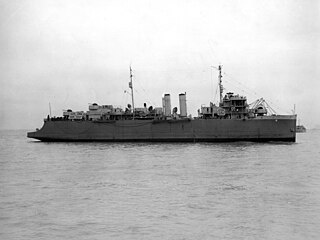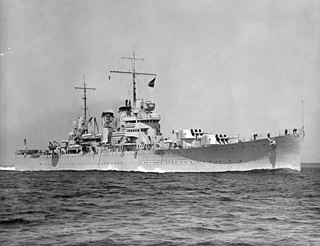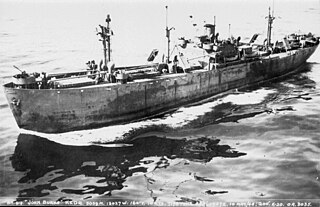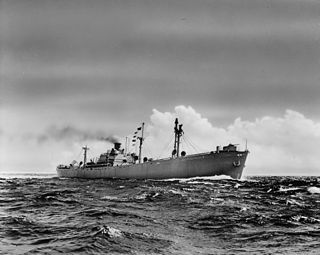
Liberty ships were a class of cargo ship built in the United States during World War II under the Emergency Shipbuilding Program. Although British in concept, the design was adopted by the United States for its simple, low-cost construction. Mass-produced on an unprecedented scale, the Liberty ship came to symbolize U.S. wartime industrial output.

USS Trout (SS-202) was the fifth Tambor-class submarine commissioned in the United States Navy, serving in the Pacific from 1941 to 1944. She received 11 battle stars for World War II service and three Presidential Unit Citations, for her second, third, and fifth war patrols. Trout also delivered ammunition to the besieged American forces on Corregidor and brought out 20 tons of gold bars and silver pesos from the Philippine currency reserve to Pearl Harbor. During 1941, she was used as a target by a series of tests determining the vulnerability of submarines to depth charge attacks.

USS Tullibee (SS-284), a Gato-class submarine, was the first ship of the United States Navy to be named for the tullibee. Her keel was laid down on 1 April 1942 at Mare Island, California, by the Mare Island Navy Yard. She was launched on 11 November 1942 sponsored by Mrs. Kenneth C. Hurd; and commissioned on 15 February 1943, Commander Charles Frederic Brindupke in command.

USS Scamp (SS-277), a Gato-class submarine, was the first ship of the United States Navy to be named for the scamp grouper, a member of the family Serranidae.

USS Harder (SS-257), a Gato-class submarine, was the first ship of the United States Navy to be named for the Harder, a fish of the mullet family found off South Africa. One of the most famous submarines of World War II, she received the Presidential Unit Citation. Her commanding officer throughout her service, the resolute and resourceful Commander Samuel D. Dealey (1906–1944), "a submariner's submariner", was posthumously awarded the Medal of Honor, as well as four Navy Crosses during his lifetime.

USS Sand Lance (SS-381), a Balao-class submarine, was the first ship of the United States Navy to be named for the sand lance, a member of the family Ammodytidae.

USS Nelson (DD-623), a Gleaves-class destroyer, was the only ship of the United States Navy to be named for Rear Admiral Charles P. Nelson, who served during the Spanish–American War and World War I.

USS Murphy (DD-603) was a Benson-class destroyer in the United States Navy during World War II. She was named for Lieutenant John McLeod Murphy.

SS Samuel Huntington was an American liberty ship during World War II. She was the 248th liberty ship authorized by the United States Maritime Commission and was named in honor of Samuel Huntington, a Founding Father and signer of the American Declaration of Independence. SS Samuel Huntington was launched in 1942 and sailed to ports in the Pacific, South America, Africa, and the United Kingdom. She was one of a select group of liberty ships that were outfitted to carry a limited number of either troops or prisoners of war. As part of a convoy to resupply the Allied troops at Anzio, she sank after a successful German bomb attack in January 1944.

USS Weehawken (CM-12) was originally SS Estrada Palma – a car ferry built in 1920 by William Cramp & Sons of Philadelphia. It was acquired by the United States Navy on 15 June 1942; renamed Weehawken on 18 July 1942; converted to a minelayer by the Bethlehem Steel Co. at Hoboken, New Jersey; designated CM-12; and commissioned on 30 September 1942.
I-11 was an Imperial Japanese Navy Type A1 submarine that served during World War II. Designed as a submarine aircraft carrier and submarine squadron flagship, she was commissioned in 1942. She participated in the Guadalcanal campaign and patrolled off Australia, New Caledonia, and the Ellice Islands before she disappeared in 1944 during her sixth war patrol. She badly damaged the Royal Australian Navy light cruiser HMAS Hobart in 1943.

The amphibious Battle of Gela was the opening engagement of the American portion of the Allied Invasion of Sicily during World War II. United States Navy ships landed United States Army troops along the eastern end of the south coast of Sicily; and withstood attacks by Luftwaffe and Regia Aeronautica aircraft while defending the beachhead against German tanks and Italian tanks of the Livorno Division until the Army captured the Ponte Olivo Airfield for use by United States Army Air Forces planes. The battle convinced United States Army officers of the value of naval artillery support, and revealed problems coordinating air support from autonomous air forces during amphibious operations.

SS John Burke was an American Liberty Ship built during World War II, one of the 2,710 type 'EC2-S-C1' ships that carried all kinds and types of dry cargo during the war. The ship was named for John Burke, the 10th Governor of North Dakota. Burke was built at Kaiser Shipbuilding Company's Oregon Shipbuilding yard in Portland, Oregon. Burke's keel was laid November 20, 1942 and the hull was launched on December 13. After fitting-out, Burke was delivered to the US Maritime Commission on December 23, just 33 days after construction began. The War Shipping Administration then placed Burke under management of the Northland Transportation Company.

SS William S. Ladd was an American Liberty ship built during World War II, one of the 2,710 type 'EC2-S-C1' ships that carried all kinds and types of dry cargo during the war. She was named for William S. Ladd, an American politician and businessman in Oregon, who twice served as Portland's mayor in the 1850s. The ship's keel was laid on August 29, 1943, and 15 days later, on September 13, the hull was launched. William S. Ladd was fitted out in seven days, and was delivered to the U.S. Navy on September 20. The Navy placed Ladd under charter to Weyerhaeuser Steamship Co.

SS Elmira Victory was a Victory ship built during World War II under the Emergency Shipbuilding program. It was built and launched by the Oregon Shipbuilding Corporation on May 12, 1944 and completed on May 31, 1944. The ship's United States Maritime Commission designation was VC2-S-AP3 and hull number 105 (1021). The ship was Oregon Shipbuilding Corporation's 21st victory ship. The Maritime Commission turned it over for Merchant navy operation to a civilian contractor, the Isthmian Steamship Company under the United States Merchant Marine act for the War Shipping Administration. She was named after the city of Elmira, New York.

The SS Berea Victory (MCV-734) was a type VC2-S-AP2 Victory-class cargo ship built for the United States during World War II. The ship was built as part of the Emergency Shipbuilding program by Permanente Metals Corporation in Yard 2 of the Richmond Shipyards in Richmond, California. Launched on 3 March 1945, the Berea Victory delivered supplies for the Pacific War.

SS Hobart Baker was a Liberty ship built for the United States Maritime Commission during World War II. The ship was named in honor of Hobart Baker. Hobart "Hobey" Baker (1892–1918) was an American amateur athlete and is considered the first American star in ice hockey. He was also an American football player. The ship was assigned by the War Shipping Administration to General Steamship Company of San Francisco who operated it throughout World War II. Hobart Baker was laid down on 16 April 1943, launched on 12 May 1943 and completed on 24 May 1943, with the hull No. 1114 as part of the Emergency Shipbuilding Program, built is 38 days.

SS Lewis L. Dyche was a Liberty ship built by the Oregon Shipbuilding Corporation for the United States Maritime Commission during World War II. The ship was named in honor of Lewis Lindsay Dyche. Lewis Lindsay Dyche (1857–1915) was an American naturalist and also the creator of the Panorama of North American Plants and Animals, which was featured in the Kansas Pavilion at the 1893 World's Columbian Exposition. The ship was assigned by the War Shipping Administration, she operated by Interocean Steamship Company of San Francisco during World War II. Lewis L. Dyche was laid down on 6 November 1943, launched on 26 November 1943 and completed on 9 December 1943, with the hull No. 807 as part of the Emergency Shipbuilding Program, built is 38 days.

SS Howard A. Kelly was an American Liberty ship built in 1943 for service in World War II. Her namesake was Howard Atwood Kelly, an influential American architect of collegiate and ecclesiastical buildings.

SS Mary Cassatt was an American Liberty ship built in 1943 for service in World War II. Her namesake was Mary Cassatt, an American painter and printmaker.


















